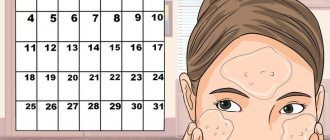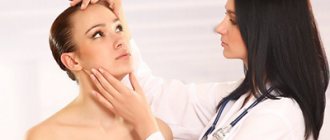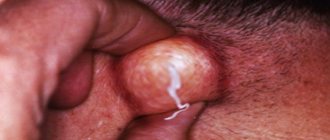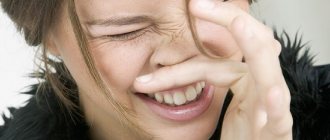What causes people to get pimples on their forehead? The answer to this question is simple and complex at the same time. Often, a rash on the forehead has hormonal causes - however, the mechanism of its appearance will differ depending on the gender and age of the person. Below we will examine this issue in detail.
In addition, the appearance of rashes can be caused by improper skin care, the use of aggressive products or the selection of products that are not suitable for your skin type. In rare cases, the appearance of small pimples on the forehead can even be caused by an unsuccessful hairstyle - for example, thick bangs, which mechanically irritate the forehead and also prevent oxygen from reaching the skin.
Among women
Among all the reasons for the appearance of acne on the forehead in girls and women, the leading role is played by hormonal fluctuations associated with the menstrual cycle, pregnancy or age-related changes during menopause. Changes in hormonal levels directly affect the condition and cleanliness of the skin, the activity of the sebaceous glands and the skin’s ability to heal itself. Therefore, to combat acne, it makes sense to consult not only a dermatologist, but also an endocrinologist.
In men
In men, acne on the forehead can also occur for hormonal reasons - due to the active production of male sex hormones, which directly affect the activity of the sebaceous glands. In addition, men naturally have thicker and oilier skin, which is prone to rashes and severe reactions to inappropriate care products or mechanical squeezing of pimples.
In teenagers
During adolescence, a powerful hormonal surge occurs, which leads to active production of sebum (sebum). With insufficient or incorrect care, sebum can clog the sebaceous ducts, causing clogged pores and the formation of open (including purulent) and closed (subcutaneous) comedones.
At this age, it is especially important to properly care for your skin, ensure compliance with all beauty rituals (toning, cleansing, moisturizing) and select cosmetics that are age-appropriate and help fight acne on the forehead in teenagers.
Causes of rashes on the forehead
There are different reasons for the appearance of a subcutaneous rash: gastrointestinal diseases, endocrine disorders, stress, mechanical damage, taking certain medications (corticosteroids, etc.)80. Let's look at the reasons why acne most often occurs on the face:
- Wrong chosen cosmetics. Firstly, you need to choose cosmetics based on your skin type, only in this way will its use bring positive results. Secondly, it is necessary to pay attention to the manifestation of an individual reaction to new cosmetics. Some substances may have a comedogenic effect.
- Unbalanced diet. Fans of fast carbohydrates (bread, cakes, chips) can pay for such a diet with clean skin. For acne, a low-carbohydrate diet is considered the most preferable. It is especially important to closely monitor the body’s reaction to milk80.
- Household reasons. The appearance of acne does not directly depend on hygiene. But rashes can be caused by using dirty makeup brushes; wiping your face with the same towel as your hands; frequent touching of the forehead with dirty hands.
- Improper skin care. If you notice small epithelial scales on your forehead, it means your skin is dry. If this has not happened before, you may be using too aggressive skin care products. What does this mean? Dry skin will try to restore balance by producing more sebum. Violation of keratinization will lead to clogged pores and the appearance of comedones.
The skin of women, men, and teenagers equally needs hydration and proper care. If rashes appear, you should not get rid of them on your own; it is better to make an appointment with a cosmetologist or dermatologist. It is imperative to identify the causes of the formation of rashes, as they may be associated with pathologies of internal organs and systems, which will significantly affect the course of therapy.
What could be the reasons?
What is the reason for the appearance of numerous pimples on the forehead? To understand this issue, it is necessary to more carefully study the structure of the skin in this area of the face. The number of sebaceous glands on the forehead is much higher than in other places. During the process of sebaceous secretion, the ducts are often blocked. The sebum that accumulates in them is an excellent habitat for various bacteria, which multiply very quickly in such favorable conditions. As a result, inflammatory processes begin with the formation of suppuration in many sebaceous ducts.
Allergic reaction
If pimples on the surface of the forehead are the result of contact with an allergen, they will appear as small, pale pink pimples, without pus filling inside. These pimples are more like a skin rash and may be accompanied by itching, redness and peeling. An allergic reaction in a person can occur to both chemicals and food.
The most common allergens that can cause small pimples on the forehead include:
- food products (chocolate, cocoa, milk, eggs, bee products);
- cheap decorative cosmetics, which contain harmful coloring pigments and compounds dangerous to the skin;
- skin care products containing large amounts of silicone, parabens;
- harmful and toxic fumes (if a person works in conditions associated with constant inhalation of toxic products, for example, in a paint factory).
To combat allergic pimples, it is necessary to eliminate the provoking factor, adjust the diet and replace all cosmetics that contain harmful chemical additives. If there is no effect, you can use antihistamine gels. The most effective of them is the gel " Fenistil"
" It should be applied in a thin layer to the affected areas 2-3 times a day. Duration of use - no more than a week.
If symptoms persist despite the use of antihistamines, you should consult a doctor, since an allergy in such a course should be excluded.
Stress and anxiety
As a result of the excitement you experience, your skin becomes oily. And excess sebum is a favorable atmosphere for the proliferation of acne bacteria. In addition to bacteria, sebum thickens and clogs the pores, and then there are bacteria: the result is a flammable mixture of inflammation and accumulated subcutaneous sebum. Stress acne can appear in the most unexpected places: acne on the chest, acne on the face, acne on the back, acne on the neck.
When stressed, the body begins to actively secrete adrenaline and norepinephrine, and also releases a lot of male hormones, which directly cause the sebaceous glands to work more actively. The stress hormone itself can also activate the sebaceous glands. Under stress, adrenocorticotropic hormone can also be released and the sebaceous glands react to its appearance by secreting sebum. Read more about hormonal acne treatment. If it so happens that a stressful situation and acne before your period occur at the same time, then expect trouble.
| Name of medicine | Image | Active substance | How to use? | Price |
| "Tenoten" | Antibodies to brain-specific protein (purified) | 1-2 tablets 2 to 4 times a day. Keep the tablets in your mouth until completely dissolved | 210-230 rubles | |
| "Persen" | Valerian rhizomes, peppermint, lemon balm | 2-3 tablets 2 to 3 times a day. Take with or without food, with water | 210-430 rubles | |
| "Afobazol" | Fabomotizol | 30 mg per day divided into 3 doses. Take after meals | 350-420 rubles |
To enhance the effect, you can use aromatherapy, yoga, massage and other methods of relaxation and stress relief.
Hygiene problems
Careless cleansing of the skin, inappropriate cosmetic products, the use of comedogenic products, heavy makeup - all this leads to clogged skin pores and the rapid development of microbes that cause the growth of pimples. Pimples on the forehead may well be the result of wearing poor headwear (friction, pressure, synthetic materials), intense sweating of the head (for example, when playing sports), or an allergic reaction.
Such acne disappears if the cause of its occurrence is eliminated. Clogging of pores and the active growth of microorganisms that provoke the appearance of acne are the result of improper cleansing of the skin, excessive use of cosmetics, and the use of comedogenic substances.
Diseases of internal organs
If acne does not go away for a very long time, despite careful hygiene, you should consult a doctor, as some diseases of the internal organs can contribute to their appearance, for example:
- gastritis, pancreatitis, colitis, duodenitis and other diseases of the digestive tract;
- hypothyroidism, diabetes mellitus and other endocrine system disorders;
- gynecological diseases occurring against the background of hormonal pathologies (endometrial hyperplasia, polycystic ovary syndrome, endometriosis);
- diseases of the heart and blood vessels, in which the conductivity of the arteries is impaired (atherosclerosis).
Quite expensive (500-770 rubles), but a very effective drug in the form of a gel for external use. Contains a combination of adapalene and clindamycin - substances with a wide spectrum of antimicrobial activity. "Klenzit-S" quickly destroys pathogenic flora, relieves inflammation, and promotes the regeneration of damaged skin. Apply the product 2-3 times a day to cleansed facial skin in a thin layer. The duration of use depends on the number of pimples, the degree of inflammation, signs of a purulent process and can range from 2 to 4 weeks.
"Salicylic acid"
Salicylic acid has a drying effect. I think many people know about this. Regarding stagnant spots after acne, it’s 100% true. This happens because salicylic acid, when treating acne, penetrates very deeply into the skin, causing blood flow to the site of application, which promotes tissue renewal. And when the tissues are renewed, acne spots also go away. This is one of the most important advantages of this product. The main thing here is not to overdo it and not to overdry, which can have a bad effect on the skin.
"Zinerit"
One of the most popular (mainly due to advertising) drugs for self-combat against various skin problems. It contains a local antibiotic, erythromycin, and zinc, an active component that has a disinfectant and drying effect. The drug is available in the form of a powder for preparing a solution, and the cost for one package starts from 440 rubles.
Before using the powder, you must prepare a solution according to the instructions (add the required amount of boiled water to the bottle). The product is dosed from the bottle using a special applicator. Apply the solution in a thin layer to the entire surface of the forehead 2 times a day to cleansed skin. Duration of treatment – 3 months.
"Zinerit" can be used under makeup.
"Baziron"
The active component benzoyl peroxide, which is part of Baziron AS, has a beneficial effect on each of the stages of acne formation, blocking the negative factors that contribute to their formation. The ability to prevent the formation of comedones is directly related to keratolytic activity, which consists in splitting the scales of the surface layer of the skin. These horny formations, which are tiny scales, combined with sebum form the basis for the formation of acne plugs that clog the pores.
Treatment of acne on the forehead: what to do if you have acne?
The appearance of even one or two elements of acne on the forehead can be very frustrating and spoil the appearance. If we are not talking about an accidental pimple before menstruation or one that appeared in winter due to rubbing with a hat, you need to seriously think about treatment. You need to get rid of rashes correctly:
- Contact your doctor. It is necessary to visit a dermatologist and undergo tests that will help determine the cause of acne. You may also need to consult a gastroenterologist, gynecologist, or endocrinologist. Some girls prefer to get rid of rashes in a cosmetologist's office. This is not a mistake, since specialists in aesthetic medicine must have qualifications in the specialty “Dermatovenereology.”96 In addition, some cosmetic procedures (laser, ozone, plasma therapy, microcurrents, etc.) can help improve the condition of the skin. But in severe forms of acne, the patient is still referred to a dermatologist.
- Forget about squeezing out acne. No matter how bad the rash looks, you need to gather your courage and remove your hands from your face. Squeezing pimples can lead to skin injury and subsequent scar formation, infection in the wound, and an increase in the number of acne elements.
- Explore your makeup bag. Often acne appears due to incorrectly selected cosmetics. If you use products that clog pores or those that have expired, then the cause of acne is obvious.
- Pay attention to hygiene. Wash your makeup brushes, change your pillowcase once a week, and prefer paper towels when wiping your face.
- Take proper care of your skin. Remove makeup with micellar water or hydrophilic oil (if you used waterproof cosmetics). Wash your face using special gels, mousses, foams, not soap. Treat your face with toner. Don't neglect moisturizing your skin.
Causes of acne in adults
11.11.2021
Acne is most often associated with a problem among teenagers. Probably, most of us in adolescence struggled with acne on the face , appearing unexpectedly and at the most inopportune moment. Acne is associated with major hormonal changes that occur in our body during this turbulent period. Teenage acne can be more or less persistent, the skin is usually oily, seborrheic, and pimples most often appear on the forehead, nose and chin, that is, in the so-called T-zone. What to do when you approach 30, even 40 years old, puberty and hormonal storm are already behind you, but the problem persists? Such ugly skin lesions deprive us of self-confidence, cause many complexes, reduce self-esteem, and cause disappointment, which affects our professional and personal lives.
Causes of acne in adults
This problem affects women more (approximately 12%) than men (up to 3%). Contrary to popular theories that hormones , they are less important in this case. Yes, these are not rare cases when women struggle with endocrine disruptions. This happens, for example, when we stop taking birth control pills. Acne medications :
- Creams, ointments, supplements
- Cleansing patches
- Spot treatments
- Day creams, night creams
- Facial gels , peelings
- Masks, tonics
A consultation with a gynecologist or endocrinologist will be required to determine the level of hormones at different levels (sex and thyroid hormones , hypothalamus, pituitary gland , adrenal glands) to eliminate deeper health problems.
The main reason is a busy lifestyle and stress, which stimulates the adrenal cortex to produce cortisol. An unhealthy diet , rich in highly processed foods and a high glycemic index, increases the production of androgens due to rapid spikes in insulin, which also causes increased seborrhea . Very often, acne is also a symptom of lactose intolerance, found in milk and dairy products. Working indoors with air conditioning, environmental pollution, smoking, and improper care, unfortunately, only work to the detriment of our skin.
How is acne in adults different from acne in teenagers?
- skin lesions are located elsewhere, i.e. most often in the lower face , around the jaw, mouth , chin and neck
- They are not as intense, but last a long time, leaving permanent scars, discoloration and unevenness on the skin.
- the skin, despite the increased production of sebum, tends to dry out
- hyperkeratosis occurs at the mouth of the hair follicles, where anaerobic bacteria begin to multiply
How to cure acne in adults?
Unfortunately, treating acne in adults is very complex, time-consuming and requires a lot of systematic work. acne care does not bring the desired results and even increases dry skin, such a person sooner or later turns to a dermatologist . The most commonly used antibiotics are antibiotics (tetracycline, doxycycline) and retinoids. The former are very often effective only during treatment, and after its completion, skin problems return. However, problems may arise due to dysregulation of the bacterial flora of the gastrointestinal tract.
The effectiveness of isotretinoin, on the other hand, is much greater, but treatment with it is not the most pleasant and requires greater sacrifice. Isotretinoin is a derivative of vitamin A, a more aggressive form, and its exact mechanism of action is not fully understood. It regulates the processes of differentiation of epidermal cells, inhibits the activity of glands, which reduces the production of sebum. During the first stage of treatment, when the skin is cleared, its condition may deteriorate sharply, but the subsequent effects are impressive. The minimum treatment period is 5-6 months under strict medical supervision. Unfortunately, the side effects of isotretinoin are very unpleasant and problematic, and the list is long, such as excessively dry skin, liver , hair loss, and even depression .
Locally, for lesions on the face , gels or creams with antibiotics (erythromycin, clindamycin), with benzoyl peroxide, which acts on anaerobic bacteria, with retinoids, azelaic acid, adapalene with keratolytic, anti-inflammatory and anti-acne properties are prescribed. Caring for such problematic skin and the correct selection of cosmetics are of great importance. The skin should be thoroughly cleansed with mild water-based preparations (avoid milk), moisturized with non-comedogenic creams rich in plant extracts, vitamins C and E, retinol (its milder forms, for example, retinaldehyde), and delicate peels should be performed, preferably based on glycolic or salicylic acid. acid.
It is also recommended to take B vitamins, especially vitamin PP (niacin), biotin, vitamins E, C and trace minerals such as zinc, selenium and copper. The beneficial properties of pansies for skin conditions have also been known for centuries . Let's not forget to change our diet to more fresh fruits and vegetables, limit highly processed foods, fast food full of unhealthy fats, sweets and salt.
Published in Dermatology Premium Clinic
How to treat acne on the forehead using Azelik® gel?
The dream of clear skin can be achieved if you approach acne treatment correctly. It should be prescribed by a dermatologist. For mild to moderate acne, the doctor may recommend the use of azelaic acid, for example, Azelik®5,9 gel.
The drug must be used twice a day, applied to previously cleansed, dry skin5. The first results from using the drug usually become noticeable after a few weeks5.
*acne
Acne in women and men: are there any differences?
Before getting rid of acne, it is worth understanding whether there is a difference in their formation and treatment.
- The male dermis is much thicker and oilier, and therefore can be several times more susceptible to various inflammatory processes. In the body, androgens, that is, hormones of the stronger sex, are responsible for the functioning of the glands.
- In the female version, the culprit is most often an imbalance of substances such as progestogens and estrogens. Even after the body goes through puberty, there remains a risk of hormonal imbalances due to the presence of menstruation, pregnancy and lactation.
When the defect is caused by other reasons, for example, poor quality care or gastrointestinal diseases, then no difference by gender is observed. The only provoking factor is naturally oilier skin and sometimes various concomitant diseases.
Let's sum it up
Thus, it became completely clear why a lot of acne appears on the forehead of girls and women, children and teenagers, boys and men, because the reasons often lie on the surface. By providing the skin with competent, high-quality, and most importantly, timely care, you can most often get rid of the problem or even prevent it using good, proven and reliable means. However, sometimes this is associated with the development of any diseases, then you definitely won’t be able to do without contacting a specialist.
Prevention
In order not to worry about how to solve the problem, you can simply prevent it by taking various preventive measures in time:
- Proper deep cleansing.
- Timely care.
- Selecting suitable cosmetics.
- Regular checks for internal problems and diseases.
- Maintaining hygiene.
- Proper diet and balanced nutrition.
- Moderate physical activity.
- Rinse off decorative cosmetics at night.
- Visiting a dermatologist and cosmetologist.
Treatment
It is forbidden to squeeze pimples on the forehead, as this can cause infection, increase the number of rashes, and also provoke serious health consequences.
Self-medication is dangerous with complications!
Attention
Despite the fact that our articles are based on trusted sources and have been tested by practicing doctors, the same symptoms can be signs of different diseases, and the disease may not proceed according to the textbook.
Pros of seeing a doctor:
- Only a specialist will prescribe suitable medications.
- Recovery will be easier and faster.
- The doctor will monitor the course of the disease and help avoid complications.
find a doctor
Do not try to treat yourself - consult a specialist.
Treatment of inflammatory processes on the skin is often a lengthy process. This is assumed to be the active secretion of subcutaneous sebum in this area of the face. Treatment begins with eliminating the root cause that caused such a pathology.
Cosmetic treatment
If there is minor damage to the skin of the forehead, it is recommended to visit a cosmetologist in order to implement a set of measures to counteract subcutaneous acne. These include the following:
- Professional masks that prevent the appearance of rashes.
- Cleaning the skin.
- Microdermabrasion. A skin peel that uses hard crystals to remove dead skin cells. It has a beneficial effect on accelerating blood circulation and improves the general condition of the dermis.
- Acid peeling. Identical to the above method, however, the active component is able to penetrate deeper into the cells.
- Laser resurfacing. The top layer of cells is removed using a laser.
- Disincrustation. Opening the tumor and removing pus.
- Mesotherapy. The introduction of medications under the skin that help eliminate the inflammatory process and restore it.
These measures can be taken after prior consultation with a doctor.
Drug therapy
In difficult situations of skin damage in the forehead area, systemic and local treatment is prescribed:
- Antibacterial therapy.
- Use of systemic retinoids.
- Hormonal treatment.
- Use of vitamins.
- Autohemotherapy.
- Use of topical retinoids
The selection of drugs should be carried out by the attending physician.
Physiotherapy
Physiotherapy and hardware methods for treating internal acne in the forehead area involve:
- Ultraviolet irradiation (has a beneficial effect on eliminating rashes and counteracts pathogenic microorganisms).
- Phototherapy (used for speedy tissue restoration).
- Magnetic therapy (characterized by a resorption effect).
- Ozone therapy (eliminates swelling, inflammation and destroys harmful bacteria through oxygen).
- ELOS therapy (influence on inflamed areas with blue light pulses).
Before prescribing such manipulations, a comprehensive diagnosis should be carried out.
Symptoms
Due to the further formation of inflammation, infection of the damaged area with bacteria that are constantly present on the human skin, an internal purulent pustule appears.
On the outside, it is a white or yellow growth that protrudes above the skin and has no way out. Since the pus is completely hidden by a layer of skin, it is extremely difficult to eliminate such a formation.
In certain situations, the accumulation of pus leads to the rapid development of a rash. During advanced pathology, large nodes will give the skin its characteristic bumpiness and bright red color.
Pimples in the forehead area may not form purulent pustules for a long time, causing itching, discomfort, and pain when touched. Small internal pimples are often located, in addition to the forehead, on the nose and lips, causing general inflammation in these areas.
Why can our articles be trusted?
We make health information clear, accessible and relevant.
- All articles are checked by practicing doctors.
- We take scientific literature and the latest research as a basis.
- We publish detailed articles that answer all questions.
When the disease is caused by a subcutaneous mite, the rash is multiple, has an unnatural reddish tint and is localized under a thin layer of skin. In some situations, symptoms are supplemented by itching and flaking.











